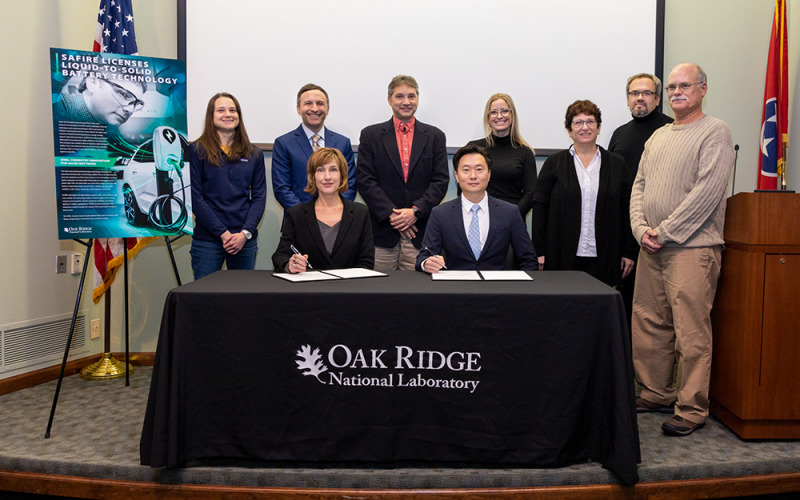Reviewed by Danielle Ellis, B.Sc.Nov 21 2022
The Oak Ridge National Laboratory of the Department of Energy has licensed battery electrolyte technology to Safire Technology Group. The set of five patented innovations is intended for use as a drop-in additive for lithium-ion batteries that avoids impact explosions and fires.
 ORNL inventors and Safire Technology Group leadership attended a licensing event at the lab on Nov. 15. Standing, from left to right, are Katie Browning, Mike Grubbs, Gabriel Veith, Hayley Kleciak, Beth Armstrong, Sergiy Kalnaus and Kevin Cooley. Seated are Susan Hubbard and John Lee. Image Credit: Genevieve Martin/ORNL, US Dept. of Energy.
ORNL inventors and Safire Technology Group leadership attended a licensing event at the lab on Nov. 15. Standing, from left to right, are Katie Browning, Mike Grubbs, Gabriel Veith, Hayley Kleciak, Beth Armstrong, Sergiy Kalnaus and Kevin Cooley. Seated are Susan Hubbard and John Lee. Image Credit: Genevieve Martin/ORNL, US Dept. of Energy.
Safire, earlier known as BTRY, intends to establish facilities in East Tennessee as part of its goal to commercialize liquid-to-solid battery technology.
Improving battery technology is critical to building a clean energy future for our country. This technology has implications for several industries, ultimately making battery systems safer, more efficient and more stable.
Susan Hubbard, Deputy, Science and Technology, Oak Ridge National Laboratory
The risk of battery cells catching fire or exploding when impacted—as in a car crash—and causing property loss, significant injuries, or deaths is a major barrier to the widespread use of battery technology for electric vehicles and aircraft, such as unmanned aerial vehicles.
SAFIRE, or Safe Impact Resistant Electrolyte, technology developed by ORNL eliminates this risk by utilizing а unique electrolyte formulation that transforms the electrolyte from liquid to solid upon impact.
A thin piece of plastic divides the two electrodes in a lithium-ion battery. If the battery is ruptured and the plastic covering breaks, the electrodes may come into contact, causing the liquid electrolyte in the battery to catch fire. Under impact in SAFIRE, the electrolyte hardens, preventing contact between electrodes.
By eliminating the need for heavy protective covering around the battery, the approach can dramatically lower vehicle weight and enhance range.
SAFIRE will transform the car industry, particularly as we pivot towards electric vehicles. The additive is easy to incorporate into existing battery-making processes and provides users with a safer alternative that is lighter and more effective than conventional battery protection, resulting in higher performance and lower total cost of ownership.
John Lee, Co-Founder and Chief Executive Officer, Safire Technology Group
The technique provides projectile and ballistic protection in defense applications while decreasing the weight of defense systems and equipment.
Lee and Safire’s other cofounder, Mike Grubbs, are also working with government agencies and industry to create technology for electric vertical takeoff and landing, or eVTOL, aircraft, e-bikes, and other Li-ion-powered equipment.
This announcement further strengthens our long-term collaboration with ORNL and allows us to begin commercial testing. We are also exploring new partnerships and identifying prototyping opportunities with automotive, e-bike and eVTOL manufacturers.
Mike Grubbs, Co-Founder, Safire Technology Group
SAFIRE’s inventor, ORNL’s Gabriel Veith, has been working on developing and refining the battery technology since 2014. Veith has received two R&D 100 Awards, one of which was for SAFIRE. ORNL colleagues Beth Armstrong, Hsin Wang, Sergiy Kalnaus, Katie Browning, and Kevin Cooley are also on the development team.
Veith adds, “The best part of working at ORNL is the team environment. This team has a rheologist, a ceramicist, an electrochemist, mechanics experts, materials testers—all those together make this technology work. This is not the work of a single person—teamwork allowed us this really unique opportunity. Having a diversity of people, experiences and backgrounds really helps to develop ideas.”
SAFIRE was initially funded by the ORNL Seed Money program, and it was later supported by the DOE’s Advanced Research Projects Agency–Energy. The lab’s Technology Innovation Initiative and FedTech’s Startup Studio, a venture firm program focused on promoting deep technology, both contributed to the commercialization effort.
2018 Technology Innovation Program: Safe Impact Resistant Electrolytes (SAFIRE)
Video Credit: Oak Ridge National Laboratory